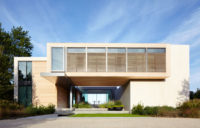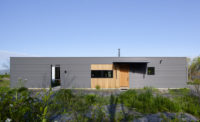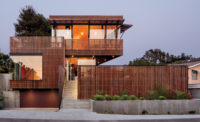Around eight years ago, Ken Goto purchased an Edwardian house in San Francisco’s North Beach neighborhood. The property included a separate structure behind the main residence, not visible from the street: a narrow, three-story stack of volumes with a facade of glass, steel, and ipe, snugly fit into the tight, rectangular backyard. Charmed by the hidden contemporary edifice, Goto found the architects—husband-and-wife team Lisa Iwamoto and Craig Scott—and asked them to design a small family vacation house on a craggy meadow in the hills of Napa County.
Goto, an engineer who has worked for Apple and Microsoft, envisioned a one-story structure that would sit lightly on the ground, unusual in appearance and in striking contrast to the rugged landscape. “I very much like structure and straight lines,” says Goto, “so my original concept was more of a modern box.”
After considering the vastness of the site, which faces mountains to the west and overlooks a lake to the east, the architects came up with a form that departed from their client’s initial suggestion but would afford sweeping panoramic views. Again playing with geometries and negative space, they came up with a hexagonal plan, the interior punctured by a central rhombus-shaped courtyard. Iwamoto and Scott configured four rectilinear spaces—a living/kitchen/dining area, a master bedroom, a children’s room, and a yoga studio—around the core’s angled edges, connecting the spaces between them with four shaded trapezoidal decks to complete the hexagon.
Inside the house, an interplay of acute and obtuse angles, as well as generous glazing on both interior and exterior walls, contribute to a dynamic visual experience. “There’s this flickering back and forth between the inward focus of the central void and the outward pull of the surrounding landscape,” says Scott, “which is then enriched by the reflections that change throughout the day.”
Because the house is so spatially rich, the architects chose a subdued material palette. The coolness of the structure’s outer steel skin and interior concrete floors is juxtaposed with the decks’ white oak surfaces and, inside, walls of white birch. To amplify the house’s unusual form, LED ambient and downlights produce the effect of a glowing interior at night. All four zones open out to the surroundings with sliding doors, naturally ventilating the house.
For Goto, the off-the-grid house has become a personal project; he mounted a photovoltaic system on the garage, located just south of the residence, and installed a battery pack for on-demand hot water and in-floor radiant heating, making the building entirely self-sufficient. (He is even hoping to boost solar capacity to charge his Tesla vehicle.) Aesthetically, he finds the unexpected shape endearing. “It’s not something I’ve ever seen in such a setting—it’s like a spacecraft,” he says. “It looks wrong and right at the same time.”











